#Berenguela
Explore tagged Tumblr posts
Text

Afonso VIII de Galicia e Berenguela de Castela. Tombo do mosteiro de Toxosoutos, Lousame, século XIII.
4 notes
·
View notes
Text


Berenguela and Blanche of Castile
Daughters of Alfonso VIII of Castile and Eleanor of England, Berenguela maintained strong connections with her sister Blanche, Queen of France. Their letters are in Latin. Latin was still, at the beginning of the 13th century, the language of writing, while French and Castilian became the languages commonly spoken, even at court. Berenguela and Blanche were well-educated, competent and forceful like their formidable grandmother Eleanor of Aquitaine.
The two sisters will also lead a parallel existence, each exerting, in their own country, a comparable influence. Much like her younger sister Blanche in France, Berenguela presents an interesting case of co-rulership with her son in Castile. Furthermore, both have ties with warfare and played determinant roles in the success of military campaigns as well as access to – and maintenance of – the throne.
Berenguela and Blanche directed a great deal of their personal energy into assuring that all of their children were appropriately married. It was Blanche who suggested sending Joan of Ponthieu as a bride for her nephew Fernando after his first wife's death. Berenguela and Blanche became the mothers of fighting saints King Fernando III and King Louis IX.


In the Archives Nationales de France are nine letters written to King Louis VIII and his wife Blanche of Castile, during Louis’s brief reign from 1223 to 1226. These letters informed Louis VIII that Alfonso VIII of Castile had intended his throne to pass to a son of Louis and Blanche, if his own son Enrique died without heirs. Louis VIII should therefore immediately send his son to Castile, where his correspondents—the scions of several major Castilian noble houses—would take up arms to set him on the throne and overthrow the “foreigner” (alienus) who was in power. The most prominent of these Castilian magnates were Rodrigo Díaz de Cameros and Gonzalo Pérez de Molina. This conspiracy was an explicit attempt to dispose of the current Castilian monarchy and replace it with a new configuration of rulers. It was therefore a far more serious threat than either Rodrigo Díaz’s or Gonzalo Pérez’s earlier revolts had been. And it was aimed squarely at the legitimacy of the reigning monarchs.
The letters’ most perplexing feature is the suggestion that Blanche’s claim to the Castilian throne superseded Berenguela’s. Some historians have even taken this as evidence that Blanche was the elder sister, though that claim is patently false. Yet the plot to overthrow Fernando III was first of all an attempt to unseat Berenguela. It was through her that Fernando III claimed hereditary right and legitimate descent from Alfonso VIII. To say that Alfonso VIII had excluded Berenguela from the succession, and to describe Fernando as a “foreigner,” was to reject the Castilian identity that Berenguela had tried to reclaim during her ten years as a solitary queen in her father’s court, and that she had negotiated with varying success during her regency and the subsequent wars. It was to define her not as the daughter and sister of the latest kings of Castile, but as the cast-off wife of the king of León.
To be sure, Blanche and her sons were at least as French as Berenguela and Fernando III were Leonese. But the rebels were apparently willing to overlook this quibble; their appeal was directed as much to Louis VIII as to his queen. Besides, the threat of union with France was diminished by the fact that Blanche and Louis VIII had no fewer than five living sons at the time that they ruled France. The rebels never insisted that the son sent to them should be Louis VIII’s firstborn, and a younger brother’s accession in Castile considerably reduced the risk of union between the crowns. All five French princes were underage, but so much the better; the minorities of Alfonso VIII and Enrique I had proved how much power nobles could gain in a regency. Louis VIII was sufficiently intrigued by the rebels’ offer to have asked them for proof of their promised support. His wife, however, was likely to be less sympathetic. A combination of Blanche’s unwillingness to contribute to her older sister’s overthrow and Fernando III’s military successes after 1224 probably quashed the plot.
Sources:
JANNA BIANCHINI,THE QUEEN'S HAND: POWER AND AUTHORITY IN THE REIGN OF BERENGUELA OF CASTILE
Regine Pernoud, La Reine Blanche
#women in history#berenguela de castilla#berengaria of castile#blanca de castilla#blanche of castile#louis viii#fernando iii#louis ix#alfonso viii#eleanor of england#eleanor of aquitaine#french history#spanish history
33 notes
·
View notes
Text

Berenguela, la Grande (1179-1246). Por Francisco Contreras.
#lithograph#monarquía española#reino de españa#infantes de españa#infanta de castilla#reino de castilla#francisco contreras#regente de castilla#reyes de castilla#reina de castilla#berenguela I de castilla#casa de borgoña#kingdom of spain#kingdom of castile#house of burgundy
4 notes
·
View notes
Text
Santa Catalina disputando con un filósofo ante el tribunal del Emperador Majencio (Relieve, siglo XIII)
Se trata de un relieve fechado entre los años 1252 y 1286 (siglo XIII), realizado en mármol blanco, perteneciente a la colección Ars Casacuberta Marsans. Formó parte de la exposición temporal “Alfonso X, el legado de un rey precursor”, que tuvo lugar en el Museo de Santa Cruz, de Toledo, en 2022. Se cumplían los 800 años del nacimiento de este rey que nació el día 23 de noviembre de 1221,…
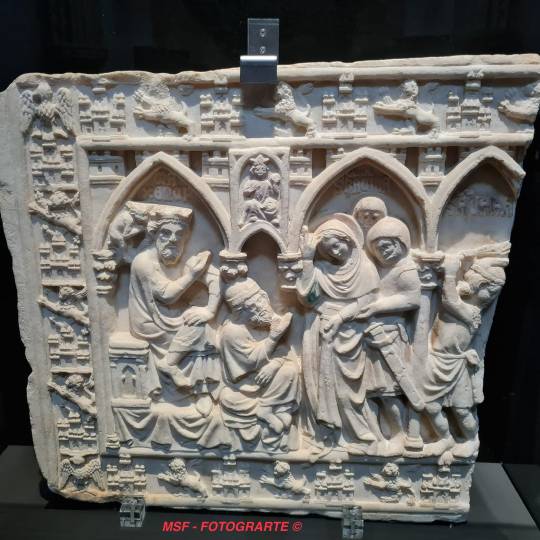
View On WordPress
#Alfonso X el Sabio#Barcelona#Beatriz de Suabia#Colección Ars Casacuberta Marsans#Edad Media#España#Exposiciones Temporales#Fernando III el Santo#Infanta Berenguela de Castilla (monja en Las Huelgas)#Monasterio de las Huelgas (Burgos)#Museo de Santa Cruz#Relieve#Siglo XIII#Toledo
4 notes
·
View notes
Text

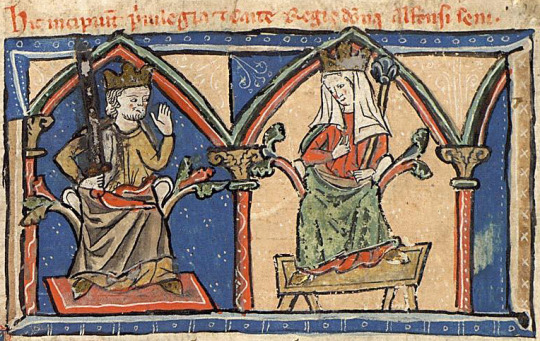




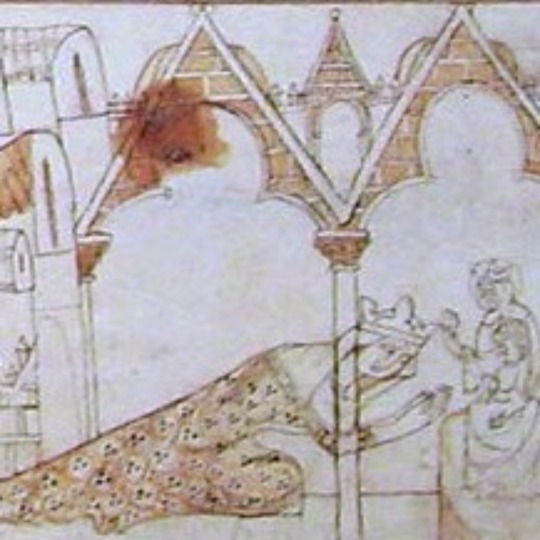

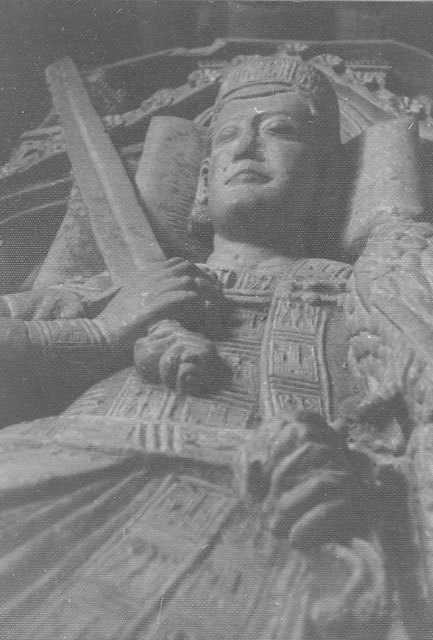

The Bastard Kings and their families
This is series of posts are complementary to this historical parallels post from the JON SNOW FORTNIGHT EVENT, and it's purpouse to discover the lives of medieval bastard kings, and the following posts are meant to collect portraits of those kings and their close relatives.
In many cases it's difficult to find contemporary art of their period, so some of the portrayals are subsequent.
1) Ferdinand III of Castile (1199/1201 – 1252), son of Alfonso IX of Leon and his wife Berenguela I of Castile
2) Alfonso IX of Leon (1171 – 1230), son of Ferdinand II of Leon and his wife Urraca of Portugal; with Berenguela I of Castile (1179/ 1180 – 1246), daughter of Alfonso VIII of Castile and his wife Eleanor of England
3) Blanche of Castile (1188 – 1252), daughter of Alfonso VIII of Castile and his wife Eleanor of England
4) Henry I of Castile (1204– 6 June 1217), son of Alfonso VIII of Castile and his wife Eleanor of England
5) Urraca of Castile (1186/ 1187 – 1220), daughter of Alfonso VIII of Castile and his wife Eleanor of England
6) Ferdinand of Leon (ca. 1192 – 1214), son of Alfonso IX of Leon and his wife Theresa of Portugal
7) Elisabeth of Swabia (1205 – 1235), daughter of Philip of Swabia and Irene Angelina
8) Alfonso X of Castile (1221 – 1284), son of Ferdinand III of Castile and his wife Elisabeth of Swabia
9) Philip of Castile (1231- 1274), son of Ferdinand III of Castile and his wife Elisabeth of Swabia
10) Eleanor of Castile (1241- 1290) daughter of Ferdinand III of Castile and his wife Joan of Ponthieu: with Edward I of England ( 1239 – 1307), son of Henry III of England and his wife Eleanor of Provence
Note: The marriage of Alfonso IX's parents got also annulled/declared void due to consanguinity, but I didn't include him on the list because this example is already present in Ferdinand III & IV
#jonsnowfortnightevent2023#canonjonsnow#asoiaf#a song of ice and fire#day 10#echoes of the past#historical parallels#medival bastard kings#bastard kings and their families#ferdinand iii of castile#alfonso ix of leon#berenguela i of castile#blanche of castile#henry i of castile#ferdinand of leon#urraca of castile#alfonso x of castile#philip of castile#eleanor of castile#edward i of england
6 notes
·
View notes
Text
Una aventura en Suez
La lluviosa mañana del 21 de octubre de 1857 el sonido de un cañonazo proveniente del castillo de Montjuich anunciaba la llegada de la fragata Berenguela de la Armada española, iba al mando del capitán de fragata José Martínez Viñalet y provenía del puerto de Génova y escalas. Fragata Berenguela (imagen del Museo Marítimo de Barcelona) A bordo de la fragata viajaban Sus Altezas Reales Antonio de…
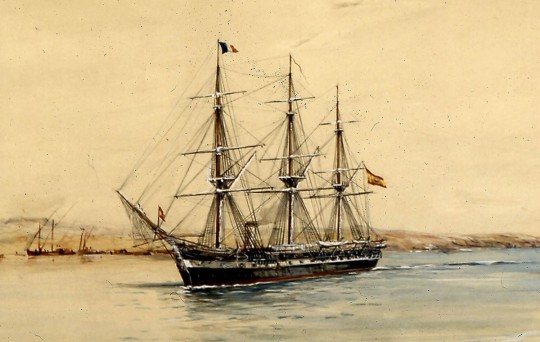
View On WordPress
#1857#Armada Española#Canal de Suez#Escuadra de Filipinas#fagata a hélice#Fragata Berenguela#Guerra del Pacífico
0 notes
Text












Women’s History Meme || Sibling Relationships (1/5) ↬ Berenguela, reina de Léon y de Castilla and Blanca de Castilla, reine de France
Queen Berenguela of Castile (1180–1246) was, in her lifetime and for some time thereafter, a dominant figure on the political landscape of the kingdoms of Castile and Leon. She typified the medieval elite woman whose ordained role in life was to be a wife and mother. The political circumstances of her native Castile, however, complicated and even enhanced Berenguela’s reproductive responsibilities. As the eldest daughter of Alfonso VIII of Castile and his wife Leonor of England, Berenguela was at different points in her young life the presumed heir to the throne. The Castilians adhered to the Visigothic principle of partible inheritance. Although favoring sons, this principle meant that daughters had a claim to inheritance. Therefore, it was possible for a woman to inherit the throne when a male heir was lacking as had happened with Alfonso VI’s daughter Urraca in 1109 and with Berenguela in 1217. Berenguela’s awareness of and concern for her own lineage derived not only from a strong, involved identification with her natal family, based on her position as her father’s daughter, but also from her awareness of her own self as an element of that lineage. Her experiences and activities can be usefully contextualized by those of her numerous and important sisters, especially Urraca, Blanche, Leonor, and Constanza. They show ways in which Berenguela was like other elite women; indeed, her life could have turned out very much like one of theirs. Despite their individual circumstances, together they help demonstrate ways in which Berenguela was and was not alone in her experiences of family, marriage, motherhood, religion, and, above all, gender. Furthermore, the sisters were key elements of Berenguela’s family; throughout their lives, they remained in contact, if only for seemingly political reasons at times. Family visits, the fostering of children, and prayers for the dead suggest affective bonds as well as a deep sensibility of filial and sisterly piety among the members of this family. Berenguela’s sister Blanca (1188–1252) is better known as Blanche of Castile, queen of France, one of the most famous women of the Middle Ages. From the time of her marriage to the French heir Louis, Blanche was destined for significance, even if only as another female link in the seemingly miraculous chain of male inheritance that had secured the Capetian throne for generations. Three years after Blanche’s husband Louis became king, he was dead, and Blanche became regent both for her young son, Louis IX, and for the kingdom of France. Blanche became queen of France at a time when the institution of queenship seems to have undergone a shift, becoming increasingly relegated to the private, domestic world of the queen’s own household; at the very least, there is a change in the way documentation presented the queen’s activities at court. Although Blanche’s own political experiences were particular to her Capetian context, examining the several parallels between her experiences and those of her sister Berenguela points to certain consistencies in thirteenth-century royal motherhood and queenship. — Berenguela of Castile (1180–1246) and Political Women in the High Middle Ages by Miriam Shadis [old version]
#women's history meme#berengaria of castile#blanche of castile#house of ivrea#house of capet#medieval#spanish history#french history#european history#women's history#history#nanshe's graphics
34 notes
·
View notes
Text

Berenguela, catedral, Santiago de Compostela, 2012.
#architecture#baroque#tower#cathedral#santiago de compostela#galicia#españa#2012#photographers on tumblr#black and white#camino santiago
22 notes
·
View notes
Text
Queens and Princesses of the Spanish Kingdoms: Ages at First Marriage
I have only included women whose birth dates and dates of marriage are known within at least 1-2 years, therefore, this is not a comprehensive list. This data set ends with the transition to Habsburg-controlled Spain.
Sancha, wife of King Fernando I of Léon; age 14 when she married Fernando in 1032 CE
Ermesinda of Bigorre, wife of King Ramiro I of Aragon; age 21 when she married Ramiro in 1036 CE
Sancha, daughter of King Ramiro I of Aragon; age 18 when she married Count Ermengol III of Urgell in 1063 CE
Constance of Burgundy, wife of King Alfonso VI of Léon & Castile; age 19 when she married Count Hugh II of Chalon in 1065 CE
Felicia of Roucy, wife of King Sancho of Aragon; age 16 when she married Sancho in 1076 CE
Agnes of Aquitaine, wife of King Pedro I of Aragon; age 14 when she married Pedro in 1086 CE
Teresa, daughter of King Alfonso VI of Léon & Castile; age 13 when she married Count Henri of Burgundy in 1093 CE
Elvira, daughter of King Alfonso VI of Léon & Castile; age 15 when she married Count Raymond IV of Toulouse in 1094 CE
Bertha, wife of King Pedro I of Aragon; age 22 when she married Pedro in 1097 CE
Elvira, daughter of King Alfonso VI of Léon & Castile; age 17 when she married King Ruggero II of Sicily in 1117 CE
Berenguela of Barcelona, wife of King Alfonso VII of Léon & Castile; age 12 when she married Alfonso in 1128 CE
Urraca, daughter of King Alfonso VII of Léon; age 11 when she married King Garcia Ramirez of Navarre in 1144 CE
Petronilla, daughter of King Ramiro II of Aragon; age 14 when she married Count Ramon Berenguer IV of Barcelona in 1150 CE
Richeza of Poland, wife of King Alfonso VII of Léon & Castile; age 12 when she married Alfonso in 1152 CE
Sancha, daughter of King Alfonso VII of Léon & Castile; age 14 when she married King Sancho VI of Navarre in 1153 CE
Constanza, daughter of King Alfonso VII of Léon & Castile; age 16 when she married King Louis VII of France in 1154 CE
Urraca of Portugal, wife of King Fernando II of Léon; age 17 when she married Fernando in 1165 CE
Eleanor of England, wife of King Alfonso VIII of Castile; age 9 when she married Alfonso in 1170 CE
Sancha of Castile, wife of King Alfonso II of Aragon; age 20 when she married Alfonso in 1174 CE
Dulce, daughter of Queen Petronilla of Aragon; age 14 when she married King Sancho I of Portugal in 1174 CE
Berenguela, daughter of King Alfonso VIII of Castile; age 7 when she married Duke Conrad II of Swabia in 1187 CE
Marie of Montpellier, wife of King Pedro II of Aragon; age 10 when she married Viscount Raymond Geoffrey II of Marseille in 1192 CE
Garsenda of Foralquier, wife of Prince Alfonso II of Aragon; age 13 when she married Alfonso in 1193 CE
Constance of Toulouse, wife King Sancho VII of Navarre; age 15 when she married Sancho in 1195 CE
Constanza, daughter of King Alfonso II of Aragon; age 19 when she married King Emeric of Hungary in 1198 CE
Blanca of Castile, daughter of King Alfonso VIII of Castile; age 12 when she married King Louis VIII of France in 1200 CE
Eleonora, daughter of King Alfonso II of Aragon; age 22 when she married Count Raymond VI of Toulouse in 1204 CE
Urraca, daughter of King Alfonso VIII of Castile; age 19 when she married King Afonso II of Portugal in 1206 CE
Mafalda of Portugal, wife of King Enrique I of Castile; age 20 when she married Enrique in 1215 CE
Sancha, daughter of King Alfonso II of Aragon; age 25 when she married Count Raymond VII of Toulouse in 1211 CE
Elisabeth of Swabia, wife of King Fernando III of Castile; age 14 when she married Fernando in 1219 CE
Eleonora of Castile, wife of King Jaime I of Aragon; age 19 when she married Jaime in 1221 CE
Berenguela, daughter of King Alfonso IX of Léon; age 20 when she married Emperor Jean I of Brienne in 1224 CE
Marguerite of Bourbon, wife of King Teobaldo I of Navarre; age 15 when she married Teobaldo in 1232 CE
Yolanda of Hungary, wife of King Jaime I of Aragon; age 20 when she married Jaime in 1235 CE
Joan of Dammartin, wife of King Fernando III of Castile; age 17 when she married Fernando in 1237 CE
Yolanda, daughter of King Jaime I of Aragon; age 13 when she married King Alfonso X of Castile in 1249 CE
Isabelle of France, wife of King Teobaldo II of Navarre; age 14 when she married Teobaldo in 1255 CE
Kristina of Norway, wife of Prince Felipe of Castile; age 24 when she married Felipe in 1258 CE
Beatriz, daughter of King Teobaldo I of Navarre; age 16 when she married Duke Hugues IV of Burgundy in 1258 CE
Constanza, daughter of King Jaime I of Aragon; age 21 when she married Prince Manuel of Castile in 1260 CE
Constanza of Sicily, wife of King Pedro III of Aragon; age 13 when she married Pedro in 1262 CE
Isabel, daughter of King Jaime I of Aragon; age 14 when she married King Louis IX of France in 1262 CE
Beatrice of Savoy, wife of Prince Manuel of Castile; age 18 when she married Pierre of Chalon in 1268 CE
Blanche of France, wife of Prince Fernando of Castile; age 16 when she married Fernando in 1269 CE
Blanche of Artois, wife of King Enrique I of Navarre; age 21 when she married Enrique in 1269 CE
Beatriz, daughter of King Alfonso X of Castile; age 17 when she married Marquis William VII of Montferrat in 1271 CE
Esclaramunda of Foix, wife of King Jaime II of Majorca; age 25 when she married Jaime in 1275 CE
Maria de Molina, wife of King Sancho IV of Castile; age 17 when she married Sancho in 1282 CE
Yolanda, daughter of King Alfonso X of Castile; age 17 when she married Diego Lopez V de Haro in 1282 CE
Juana, daughter of King Enrique I of Navarre; age 11 when she married King Philippe IV of France in 1284 CE
Maria Diaz I de Haro, wife of Prince Juan of Castile; age 17 when she married Juan in 1287 CE
Yolanda, daughter of Prince Manuel of Castile; age 12 when she married Prince Afonso of Portugal in 1287 CE
Isabel, daughter of King Pedro III of Aragon; age 17 when she married King Denis of Portugal in 1288 CE
Isabel of Castile, wife of King Jaime II of Aragon; age 8 when she married Jaime in 1291 CE
Blanche of Anjou, wife of King Jaime II of Aragon; age 15 when she married Jaime in 1295 CE
Yolanda, daughter of King Pedro III of Aragon; age 24 when she married Prince Roberto of Naples in 1297 CE
Constanza of Portugal, wife of King Fernando IV of Castile; age 12 when she married Fernando in 1302 CE
Beatriz, daughter of King Sancho IV of Castile; age 16 when she married King Afonso IV of Portugal in 1309 CE
Maria, daughter of King Jaime II of Aragon; age 12 when she married Prince Pedro of Castile in 1311 CE
Constanza, daughter of King Jaime II of Aragon; age 12 when she married Prince Juan Manuel of Villena in 1312 CE
Teresa d'Entença, wife of King Alfonso IV of Aragon; age 14 when she married Alfonso in 1314 CE
Marie of Lusignan, wife of King Jaime II of Aragon; age 42 when she married Jaime in 1315 CE
Isabel, daughter of King Jaime II of Aragon; age 10 when she married King Frederick I of Germany in 1315 CE
Eleonora of Castile, wife of Prince Jaime of Aragon; age 12 when she married Jaime in 1319 CE
Elisenda of Montcada, wife of King Jaime II of Aragon; age 30 when she married Jaime in 1322 CE
Blanca de La Cerda y Lara, wife of Prince Juan Manuel of Castile; age 10 when she married Juan Manuel in 1327 CE
Constanza, daughter of King Alfonso IV of Aragon; age 18 when she married King Jaime III of Majorca in 1336 CE
Cecilia of Comminges, wife of Prince Jaime of Aragon; age 16 when she married Jaime in 1336 CE
Maria of Navarre, wife of King Pedro IV of Aragon; age 8 when she married Pedro in 1337 CE
Leonor of Portugal, wife of King Pedro IV of Aragon; age 19 when she married Pedro in 1347 CE
Eleonora of Sicily, wife of King Pedro IV of Aragon; age 24 when she married Pedro in 1349 CE
Juana Manuel, daughter of Prince Juan Manuel; age 11 when she married King Enrique of Castile in 1350 CE
Blanche of Bourbon, wife of King Pedro of Castile; age 14 when she married Pedro in 1353 CE
Constanza, daughter of King Pedro IV of Aragon; age 18 when she married King Federico of Sicily in 1361 CE
Maria de Luna, wife of King Martin of Aragon; age 14 when she married Martin in 1372 CE
Juana, daughter of King Pedro IV of Aragon; age 29 when she married Count Juan I of Ampurias in 1373 CE
Marthe of Armagnac, wife of King Juan I of Aragon; age 26 when she married Juan in 1373 CE
Beatriz of Portugal, wife of Prince Sancho of Castile; age 19 when she married Sancho in 1373 CE
Eleonora of Aragon, daughter of King Pedro IV of Aragon; age 17 when she married King Juan I of Castile in 1375 CE
Eleonora, daughter of King Enrique II of Castile; age 12 when she married King Carlos III of Navarre in 1375 CE
Isabel of Portugal, wife of Count Alfonso Enriquez; age 13 when she married Alfonso in 1377 CE
Violant of Bar, wife of King Juan I of Aragon; age 15 when she married Juan in 1380 CE
Beatriz of Portugal, wife of King Juan I of Castile; age 10 when she married Juan in 1383 CE
Juana, daughter of King Juan I of Aragon; age 17 when she married Count Matthieu of Foix in 1392 CE
Eleonora of Albuquerque, wife of King Fernando I of Aragon; age 20 when she married Fernando in 1394 CE
Yolanda, daughter of King Juan of Aragon; age 19 when she married Duke Louis II of Anjou in 1400 CE
Blanca I of Navarre, wife of Prince Martin of Aragon; age 15 when she married Martin in 1402 CE
Juana, daughter of King Carlos III of Navarre; age 20 when she married Count Jean I of Foix in 1402 CE
Beatriz, daughter of King Carlos III of Navarre; age 14 when she married Count James II of La Marche in 1406 CE
Isabel, daughter of King Pedro IV of Aragon; age 31 when she married Count Jaime II of Urgell in 1407 CE
Margarita of Prades, wife of King Martin of Aragon; age 14 when she married Martin in 1409 CE
Maria of Castile, wife of King Alfonso V of Aragon; age 14 when she married Alfonso in 1415 CE
Catalina of Castile, wife of Prince Enrique of Aragon; age 15 when she married Enrique in 1418 CE
Isabel, daughter of King Carlos III of Navarre; age 24 when she married Jean IV of Armagnac in 1419 CE
Maria, daughter of King Fernando I of Aragon; age 17 when she married King Juan II of Castile in 1420 CE
Eleonora, daughter of King Fernando I of Aragon; age 26 when she married King Duarte of Portugal in 1428 CE
Agnes of Cleves, wife of Prince Carlos of Aragon; age 17 when she married Carlos in 1439 CE
Blanca II of Navarre, daughter of King Juan II of Aragon and Queen Blanca I of Navarre; age 18 when she married King Enrique IV of Castile in 1440 CE
Eleonora of Navarre, daughter of King Juan II of Aragon and Queen Blanca 1 of Navarre; age 15 when she married Count Gaston IV of Foix in 1441 CE
Juana Enriquez, wife of King Juan II of Aragon; age 19 when she married Juan in 1444 CE
Isabel of Portugal, wife of King Juan II of Castile; age 19 when she married Juan in 1447 CE
Joana of Portugal, wife of King Enrique IV of Castile; age 16 when she married Enrique in 1455 CE
Isabel I of Castile, wife of King Fernando II of Aragon; age 18 when she married Fernando in 1469 CE
Juana, daughter of King Enrique IV of Castile; age 13 when she married King Afonso V of Portugal in 1475 CE
Juana, daughter of King Juan II of Aragon; age 21 when she married King Fernando I of Naples in 1476 CE
Isabel, daughter of King Fernando II of Aragon; age 20 when she married Prince Afonso of Portugal in 1490 CE
Juana, daughter of King Fernando II of Aragon; age 22 when she married Felipe I of Castile in 1501 CE
Margaret of Austria, wife of Prince Juan of Aragon; age 17 when she married Juan in 1497 CE
Maria, daughter of King Fernando II of Aragon; age 18 when she married King Manuel I of Portugal in 1500 CE
Catalina, daughter of King Fernando II of Aragon; age 15 when she married Prince Arthur of England in 1501 CE
Germaine of Foix, wife of King Fernando II of Aragon; age 18 when she married Fernando in 1506 CE
112 women; average age at first marriage was 16. The eldest bride was 42 years old, and the youngest was 7.
6 notes
·
View notes
Text

HOY CELEBRAMOS A NUESTRO HERMANO SAN FERNANDO III, EL SANTO.
Fernando III, «el Santo», rey de León y de Castilla, hijo de Alfonso IX de León y de Berenguela de Castilla, nació el año 1198 en el reino leonés, probablemente cerca de Valparaíso (Zamora). Tradicionalmente se afirma que perteneció a la Tercera Orden Franciscana. Fue el rey de la reconquista del sur de España. Su visión política de altas miras es reconocida por los historiadores, y las gentes de toda clase y condición bendijeron su reinado sabio, ecuánime, prudente. En los territorios reconquistados por él, nunca hubo vencedores y vencidos. Con razón es proclamado «señor de la convivencia de cristianos, musulmanes y judíos». Contrajo dos matrimonios sucesivos, que fueron felices, y de ambos tuvo en conjunto trece hijos. Fue hombre de óptimos sentimientos y limpias costumbres. Además de administrar con sabiduría sus reinos, promovió las artes y las ciencias, y colaboró en la propagación de la fe. Vivió rodeado del respecto y afecto de unos y otros, y su muerte fue llorada por todos. Murió en Sevilla el 30 de mayo de 1252.-
10 notes
·
View notes
Text

#tsr#thesims4#ts4#ts4 custom content#s4cc#ts4cc#sims4#ts4 download#s4cc download#s4 custom content#ts4 cc finds#sims4 cc finds#simblr#ts4 alpha#MeritSelket#UniqueSims#the sims resource#ye medieval#medieval
5 notes
·
View notes
Text

Berenguela de Barcelona
She was a very beautiful and extremely graceful young girl who loved chastity and truth and all God-fearing people.
Berenguela was the daughter of Ramon Berenguer III, Count of Barcelona and his third wife Dolça I de Gévaudaun, Countess of Provence. Although her date of birth is unknown, the sources place it between 1108 and 1116. It is known that Berenguela had a good relationship with her older sister, María de Osona, who was the daughter of the first marriage of her father with María Rodríguez, the daughter of El Cid Campeador.
In 1128 Berenguela married Alfonso VII, King of León, Castile and Galicia. She becoming the first queen of the newly reigning dynasty of the House of Ivrea. In 1135, Alfonso VII was crowned “Emperor of Spain” (Imperator totius Hispaniae) in the Cathedral of León. The imperial couple had seven children, of whom Sancho III was King of Castile and Fernando II King of León. The daughters, Constanza and Sancha, became Queens consorts of France and Navarre.
Historians who have dedicated to studying her life consider that Berenguela de Barcelona was one of the characters who deserves a privileged position in the history of Spain. She actively participated in political life and was patroness of the arts. She accompanied her husband in the battles, stopped the uprising in Asturias and heroically resisted the besieged of Toledo by the Muslims. She also introduced a taste for Provencal troubadours to the kingdom, supported writers who narrated the exploits of El Cid and encouraged pilgrimages to Santiago de Compostela, where she was buried in 1149.

Berenguela nació en el prestigioso y rico condado de Barcelona como hija del conde Ramón Berenguer III y de su segunda esposa Dulce de Provenza. La joven barcelonesa destacó por su inteligencia y gran belleza, llegando su fama hasta la corte del rey Alfonso VII de Léon, Castilla y Galicia, hijo de la legendaria reina Urraca. Al parecer fue un noble, Armengol de Urgel, quien le facilitó los trámites para entrar en contacto con los condes de Barcelona. El rey de León tenía poco más de veinte años y no estaba casado, ni siquiera había ninguna candidatura seria para un matrimonio, que tarde o temprano tendría que celebrarse.
Una vez prometida al rey Alfonso VII, Berenguela de Barcelona emprendió un largo viaje. Desde Barcelona hasta la corte de su futuro marido, debía cruzar los dominios del rey aragonés Alfonso el Batallador, quien estaba en disputa con Castilla por cuestiones territoriales y fronterizas. Para evitarlo, Berenguela y su comitiva tuvieron que hacer parte del viaje por el sur de Francia, llegar hasta el Golfo de Vizcaya y fletar unas barcazas que, bordeando la costa cantábrica, les permitieran desembarcar en un puerto controlado por los leoneses.
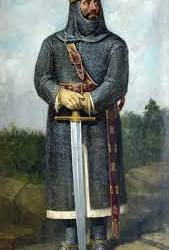
A finales de 1128 o enero de 1129, los prometidos contraían matrimonio en la villa de Saldaña. Con motivo de las celebraciones de los esponsales, que duraron varios días, se dice que tuvo lugar la primera corrida de toros celebrada en la Península. La pareja imperial tuvo siete hijos, destacándose Sancho III de Castilla y Fernando II de León. La joven reina forjó una gran amistad con su cuñada la infanta Sancha Raimúndez, llegando a ser ambas las principales consejeras de Alfonso VII. Berenguela participó en la política de forma activa, fue la principal responsable de apagar la rebelión del conde de Asturias Gonzalo Peláez y acompañó a su esposo a la guerra en muchas ocasiones, participando así de sus victorias.
En 1135 tuvo lugar la coronación de Alfonso VII como Imperator totius Hispaniae en la catedral de León, gran parte de los nobles presentes en el acto habían llegado gracias a los contactos de la reina y su familia; así su hermano Ramón Berenguer IV, Armengol de Urgel, el conde Alfonso Jordán de Tolosa, el de Montpellier, el duque de Gascuña, el de Foix y otros grandes señores del Sur de Francia. A ella, entonces, cupo el gran honor de ser la Emperatriz consorte de Hispania.

Nos dice la crónica de Alfonso VII que en 1139 la reina Berenguela fue la responsable de una heroica resistencia en Toledo. Habiendo partido su marido al sitio del castillo de Aurelia, encargó a su esposa la defensa de la ciudad. Pero la campaña se alargó demasiado y Toledo fue sitiada por las tropas musulmanas. Berenguela reunió un pequeño ejército, pero, consciente de su inferioridad, decidió intentar una jugada diplomática para tratar de evitar la lucha. Indignada por la destrucción de la torre de San Servando, cercana a la ciudad, Berenguela envió un mensajero con una carta al campo enemigo que decía lo siguiente:
"¿No conocéis que es mengua de caballeros y capitanes esforzados acometer a una mujer indefensa cuando tan cerca os espera el emperador? Si quereis pelear id a Aurelia y allí podréis acreditar que sois valientes, como aquí dejar demostrado que sois hombres de honor si os retiráis".
La reina Berenguela apareció además sentada sobre un trono real en una de las torres, rodeada de sus doncellas, que cantaban con tímpanos, cítaras, címbalos y salterios. Los musulmanes quedaron impresionados por la nobleza de la reina y levantaron inmediatamente el cerco, marchando a luchar contra Alfonso. Cuando el alcaide de Toledo, Nuño Alfonso, entró victorioso en la ciudad portando las cabezas de los emires de Sevilla y Córdoba, las mandó colgar de las torres del alcázar, pero la reina se apiadó, ordenando que las embalsamaran y enviaran a sus viudas en cofres de oro. Una torre en Toledo (la Torre de la Reina) recuerda la gesta de la reina Berenguela.
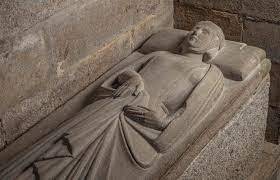
Berenguela es recordada como una prudente reina que sacrificó sus sentimientos dando prioridad a los intereses de la corona. Cuando de las infidelidades de su esposo con la noble asturiana Gontrodo Pérez nació una hija, doña Urraca, la reina perdonó a su esposo y quiso ganárselo mediante el cariño. Aún más, cuando Urraca casó con el rey de Navarra García el Restaurador, la reina Berenguela se encargó de preparar los esponsales con gran pompa y asistió, dando gran realce a la ceremonia. Mujer culta, Berenguela fue una gran mecenas y amante de las artes, a ella se debe el impulso de la poesía provenzal en el reino, apoyó a escritores que narraban las hazañas del Cid y fomentó el peregrinaje a Santiago de Compostela, donde fue enterrada. Su muerte fue muy lamentada, tanto que, según los historiadores de la época, el año 1149 fue usado en los documentos como punto de partida para fechar los acontecimientos, bajo la fórmula "año en que falleció la señora emperatriz".
#Berenguela de Barcelona#Berenguela Berenguer#Berengaria of Barcelona#Spanish history#women in history#Alfonso VII
26 notes
·
View notes
Text
Best Hotels in Alcázar de San Juan, Ciudad Real, Castile–La Mancha, Spain
Alcázar de San Juan, a captivating city nestled in Spain’s Castile-La Mancha region, enthralls visitors with its rich history, architectural wonders, and vibrant culture. Explore the iconic Castillo de Doña Berenguela (Doña Berenguela’s Castle), delve into the fascinating Museo Provincial de Ciudad Real (Ciudad Real Provincial Museum), or stroll along the lively Gran Vía. Alcázar de San Juan…
View On WordPress
0 notes
Text
Fernando III el Santo fue rey gracias a las dos esposas de su padre, Alfonso IX de León. La primera, Teresa de Portugal, logró que sus hijas cedieran sus derechos al trono de León en favor de Fernando. La segunda, su madre Berenguela, abdicó para nombrarlo rey de Castilla.


0 notes
Text
EL CONDE SISEBUTO; Joaquín Abatí Díaz A cuatro leguas de Pinto y a treinta de Marmolejo, existe un castillo viejo que edificó Chindasvinto. Perteneció a un gran señor algo feudal y algo bruto; se llamaba Sisebuto, y su esposa, Leonor, y Cunegunda, su hermana, y su madre, Berenguela, y una prima de su abuela atendía por Mariana. Y su cuñado, Vitelio, y Cleopatra, su tía, y su nieta, Rosalía, y el hijo mayor, Rogelio. Era una noche de invierno, noche cruda y tenebrosa, noche sombría, espantosa, noche atroz, noche de infierno, noche fría, noche helada, noche triste, noche oscura, noche llena de amargura, noche infausta, noche airada. En un gótico salón dormitaba Sisebuto, y un lebrel seco y enjuto roncaba en el portalón. Con quejido lastimero el viento fuera silbaba, e imponente se escuchaba el ruido del aguacero. Cabalgando en un corcel de color verde botella, raudo como una centella llega al castillo un doncel. Empapada trae la ropa por efecto de las aguas, ¡como no lleva paraguas viene el pobre hecho una sopa! Salta el foso, llega al muro, la poterna está cerrada. -¡Me ha dado mico mi amada! -exclama-. ¡Vaya un apuro! De pronto, algo que resbala siente sobre su cabeza, extiende el brazo, y tropieza ¡con la cuerda de una escala! -¡Ah!... -dice con fiero acento. -¡Ah!.. -vuelve a decir gozoso. -¡Ah!.. -repite venturoso. -¡Ah!.. -otra vez, y así, hasta ciento. Trepa que trepa que trepa, sube que sube que sube, en brazos cae de un querube, la hija del conde, la Pepa. En lujoso camarín introduce a su adorado, y al notar que está mojado le seca bien con serrín. -Lisardo ... mi bien, mi anhelo, único ser que yo adoro, el de los cabellos de oro, el de la nariz de cielo, ¿qué sientes, di, dueño mío?, ¿no sientes nada a mi lado?, ¿que sientes, Lisardo amado? Y él responde: -Siento frío. -¿Frío has dicho? Eso me espanta. ¿Frío has dicho? eso me inquieta. No llevarás camiseta ¿verdad?... pues toma esa manta. -Ahora hablemos del cariño que nuestras almas disloca. Yo te amo como una loca. -Yo te adoro como un niño. -Mi pasión raya en locura, si no me quieres, me mato. -La mía es un arrebato, si me olvidas, me hago cura. -¿Cura tú? ¡Por Dios bendito! No repitas esas frases, ¡en jamás de los jamases! ¡Pues estaría bonito! Hija soy de Sisebuto desde mi más tierna infancia, y aunque es mucha mi arrogancia, y aunque es un padre muy bruto, y aunque temo sus furores, y aunque sé a lo que me expongo, huyamos... vamos al Congo a ocultar nuestros amores. -Bien dicho, bien has hablado, huyamos aunque se enojen, y si algún día nos cojen, ¡que nos quiten lo bailado! En esto, un ronco ladrido retumba potente y fiero. -¿Oyes? -dice el caballero-, es el perro que me ha olido. Se abre una puerta excusada y, cual terrible huracán, entra un hombre..., luego un can..., luego nadie..., luego nada... -¡Hija infame! -ruge el conde. ¿Qué haces con este señor? ¿Dónde has dejado mi honor? ¿Dónde?, ¿dónde?, ¿dónde?. ¿dónde? Y tú, cobarde villano, antipático, repara cómo señalo tu cara con los dedos de mi mano. Después, sacando un puñal, de un solo golpe certero le enterró el cortante acero junto a la espina dorsal. El joven, naturalmente, se murió como un conejo. Ella frunció el entrecejo y enloqueció de repente. También quedó el conde loco de resultas del espanto, y el perro... no llegó a tanto, pero le faltó muy poco. Desde aquel día de horror nada se volvió a saber del conde, de su mujer, la llamada Leonor, de Cunegunda su hermana, de su madre Berenguela, de la prima de su abuela que atendía por Mariana, de su cuñado Vitelio, de Cleopatra su tía, de su nieta Rosalía ni de su chico Rogelio. Y aquí acaba la leyenda verídica, interesante, romántica, fulminante, estremecedora, horrenda, que de aquel castillo viejo entenebrece el recinto, a cuatro leguas de Pinto y a treinta de Marmolejo.
0 notes
Text
Eleanor of Aquitane
Eleanor of Aquitane My 25th great-grandmother was extremely powerful. She married the king of France, and then the king of England. She ruled for her son, Richard the Lionhearted, while he was off crusading. Eleanor of Aquitane (1130 – 1204) is my 25th great grandmother Eleanor Spain Plantagenet (1162 – 1214) daughter of Eleanor of Aquitane Berenguela CASTILE LEON (1181 – 1244) daughter of…

View On WordPress
1 note
·
View note